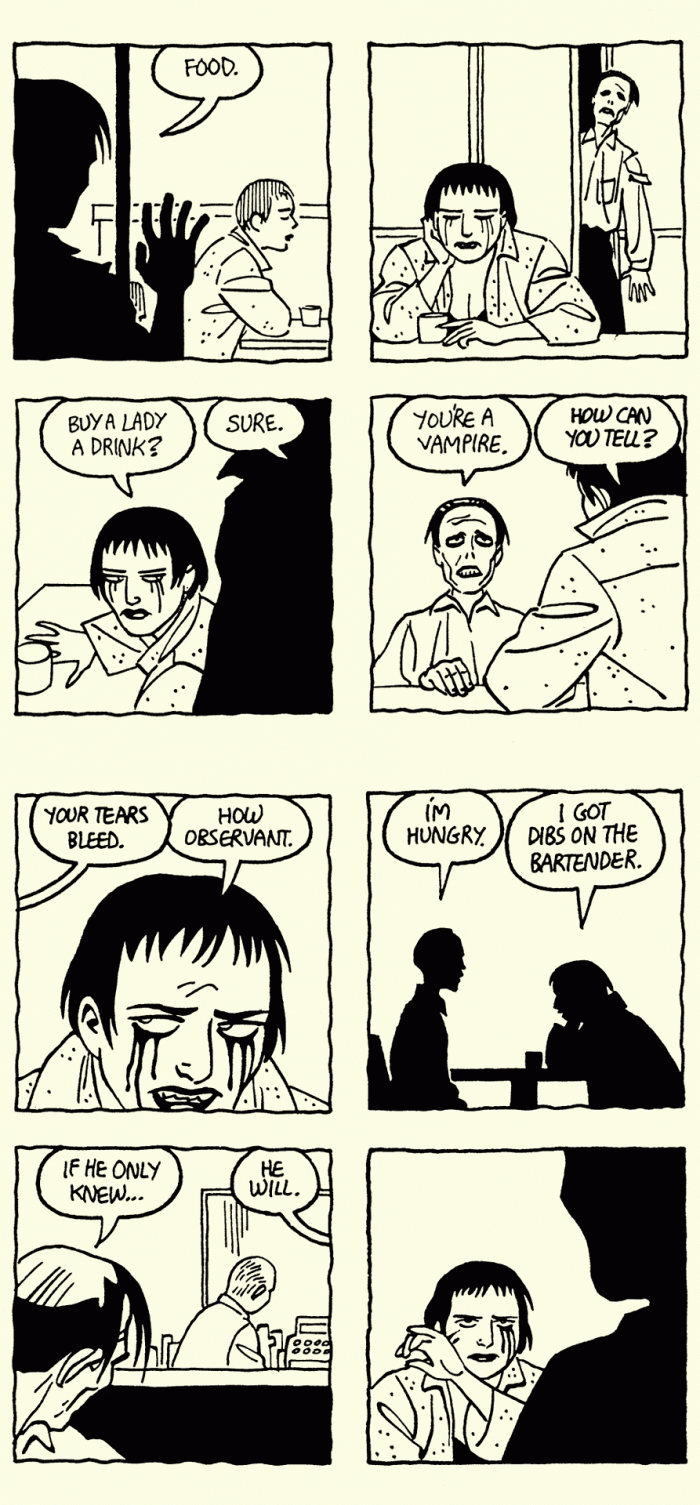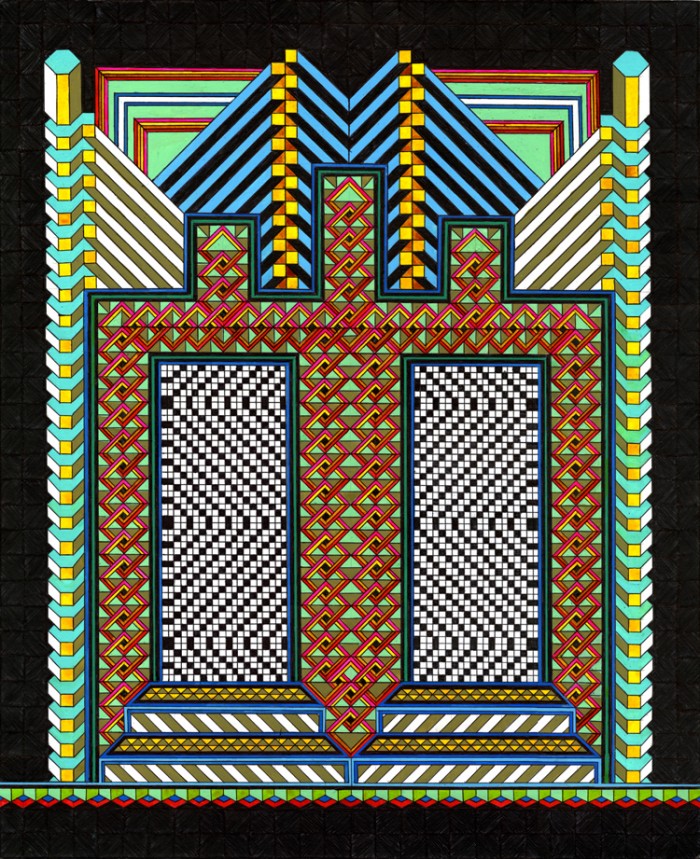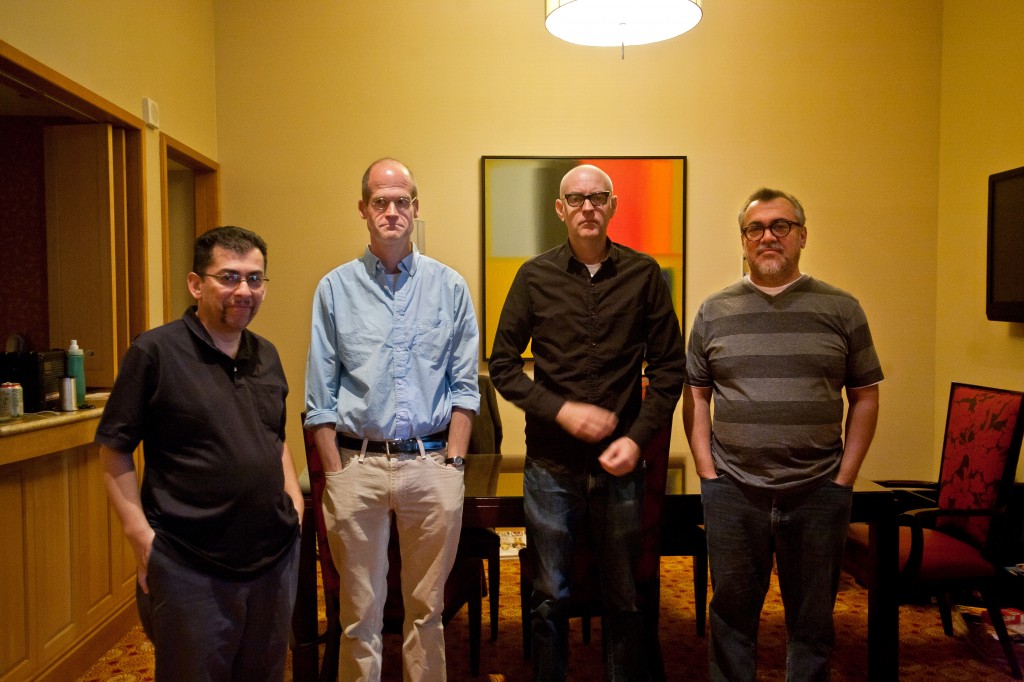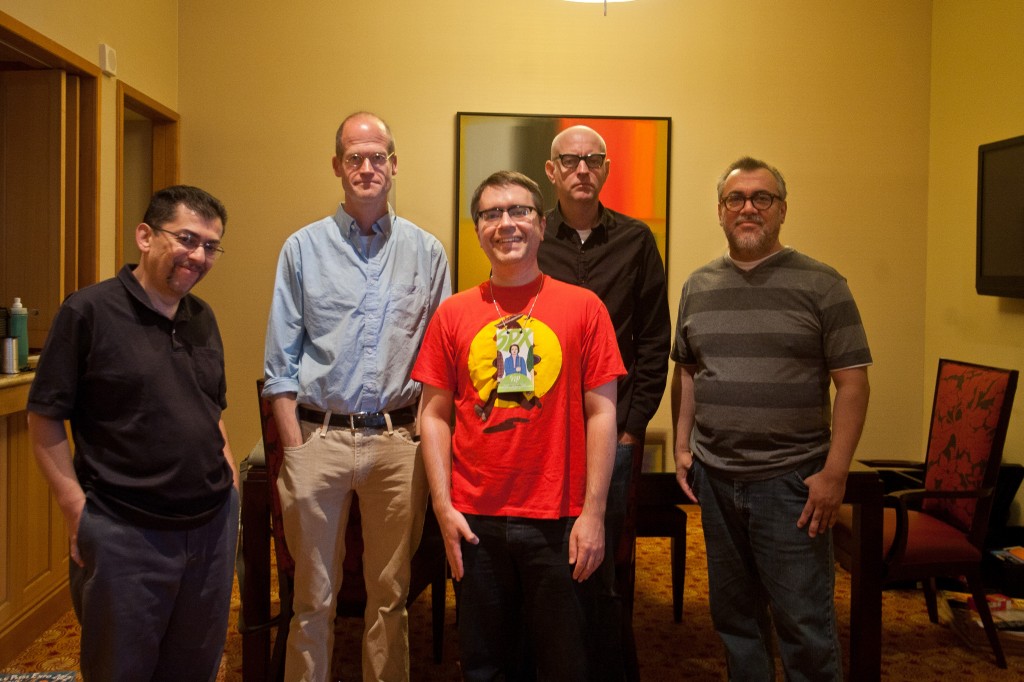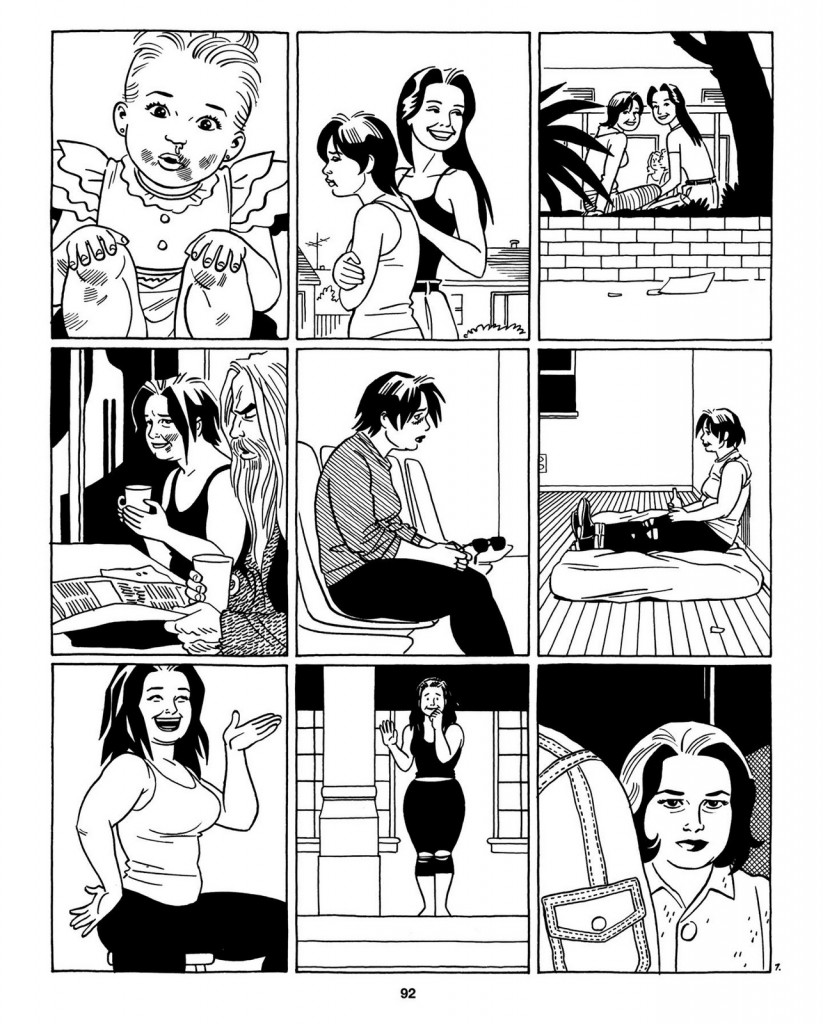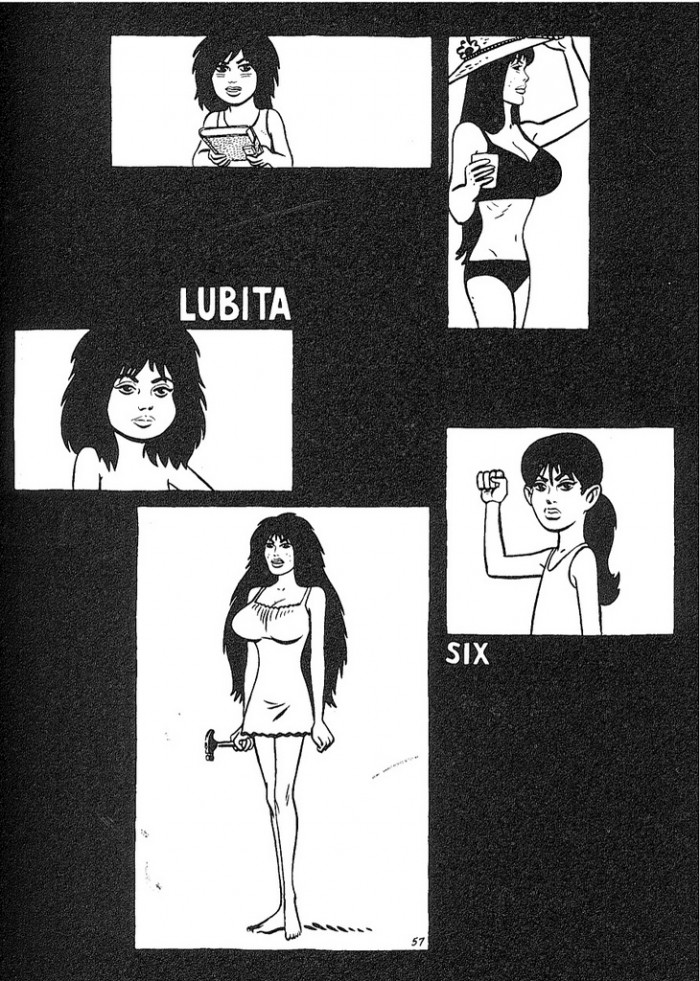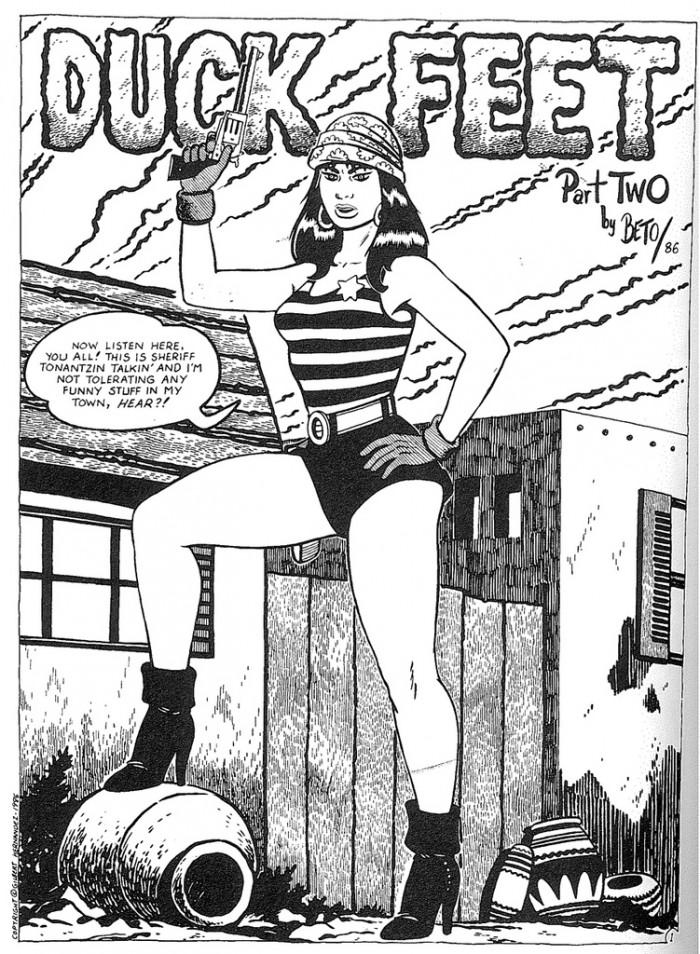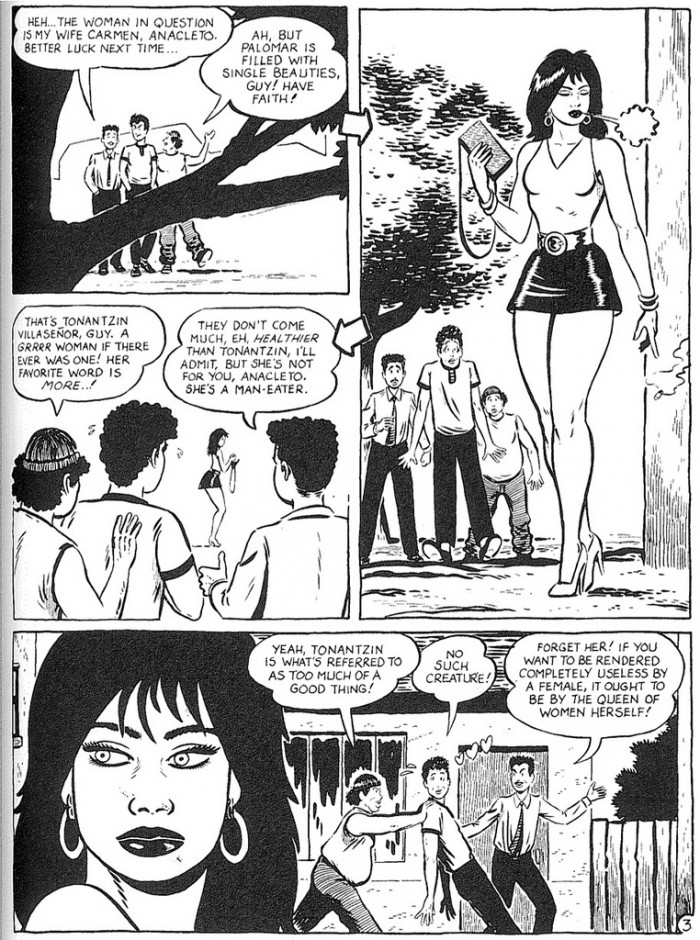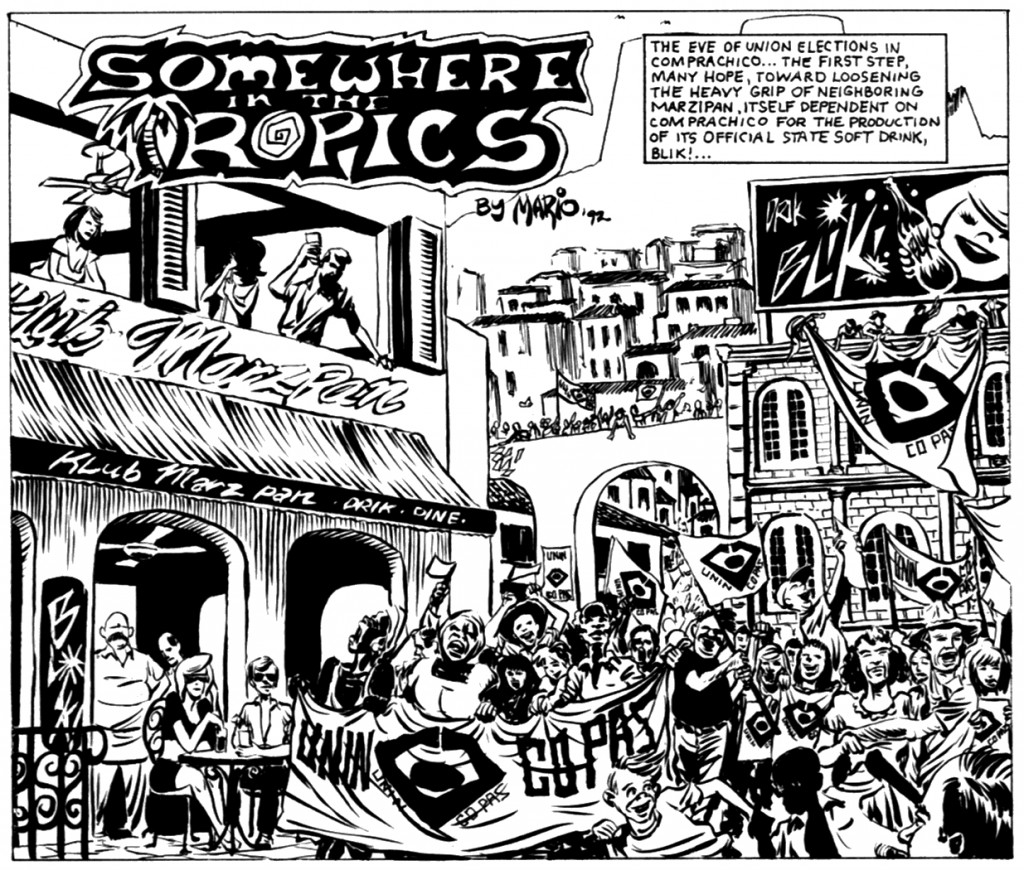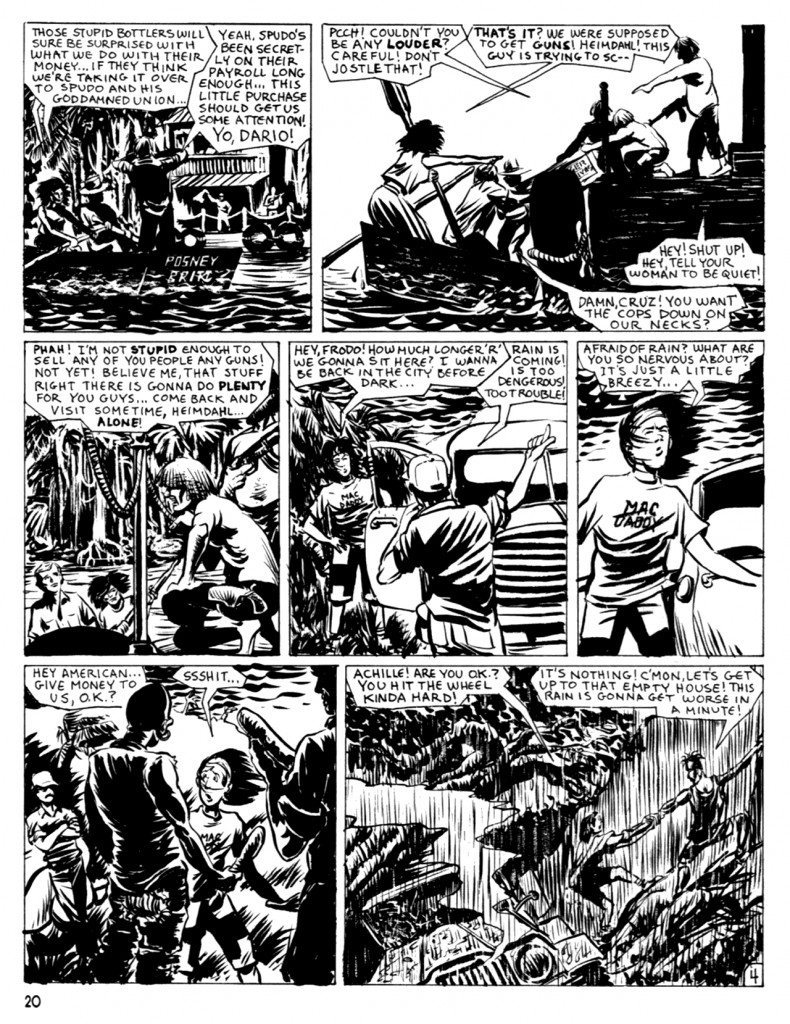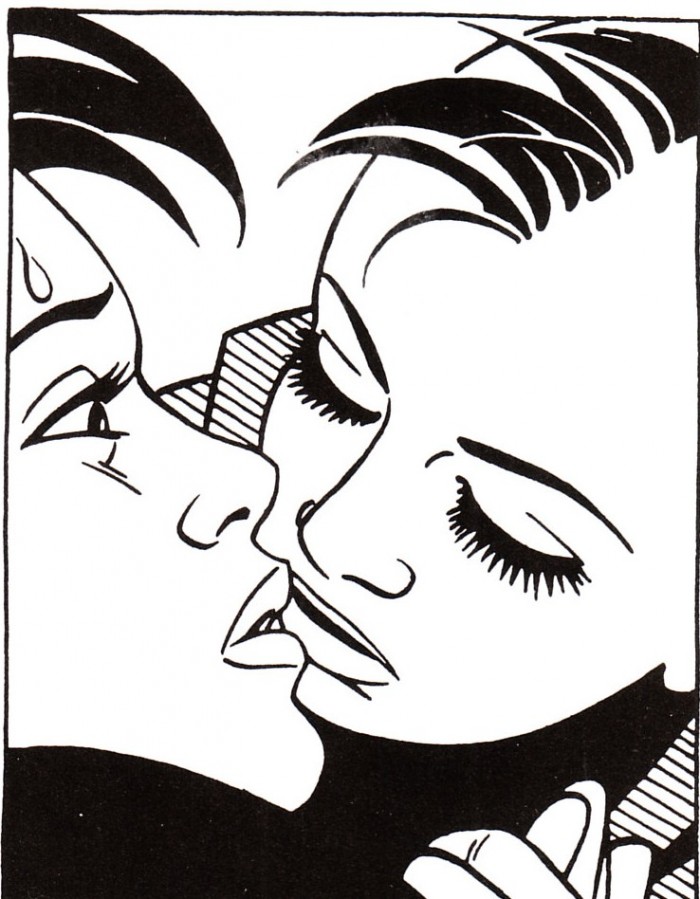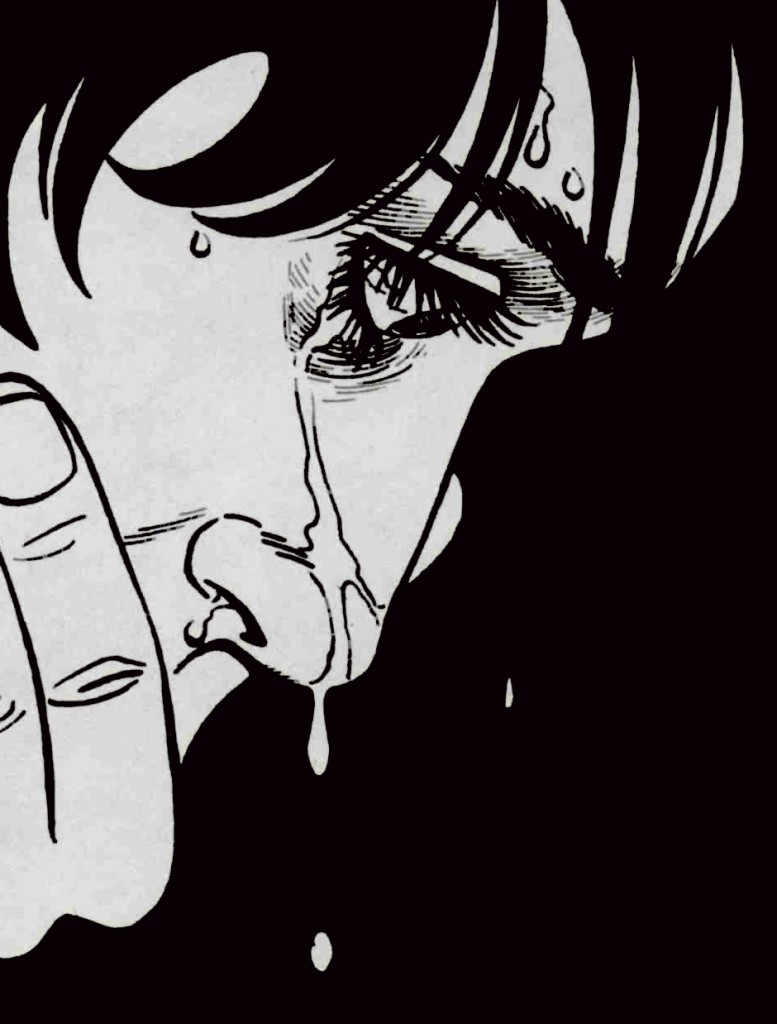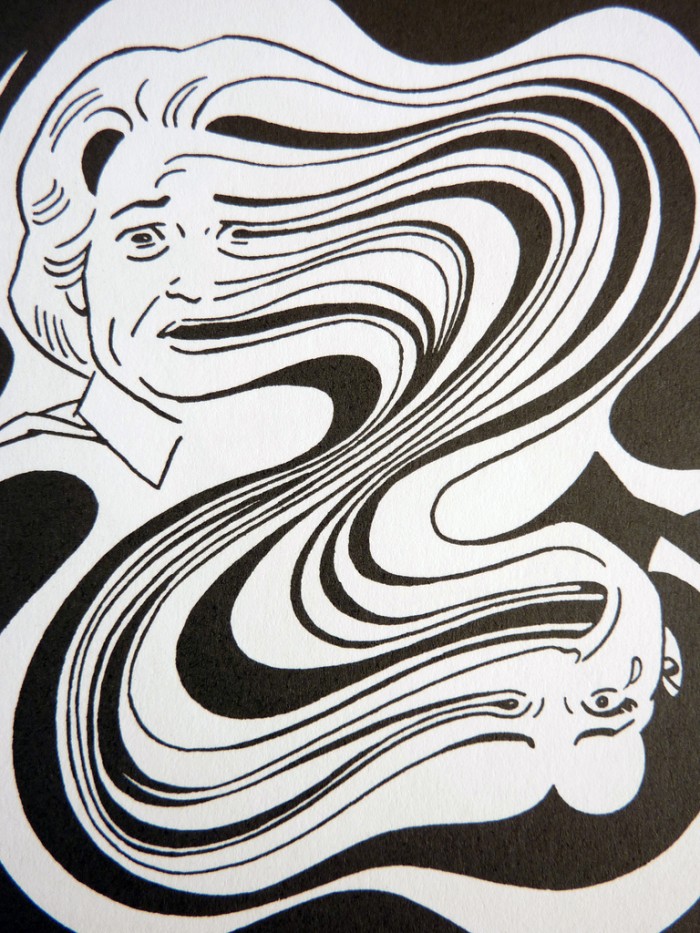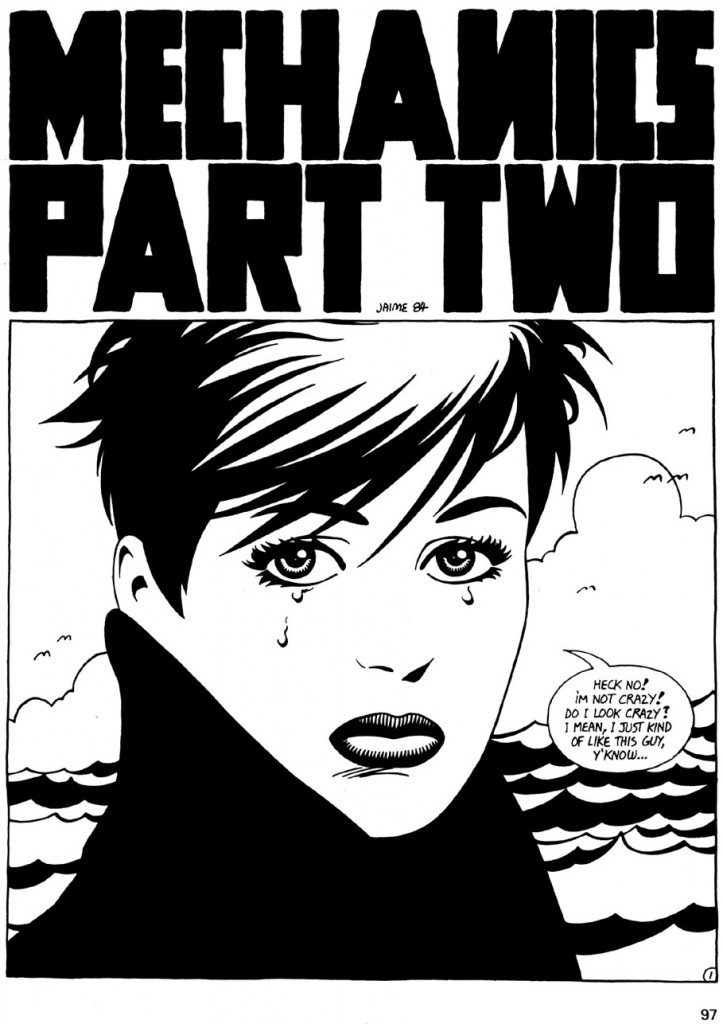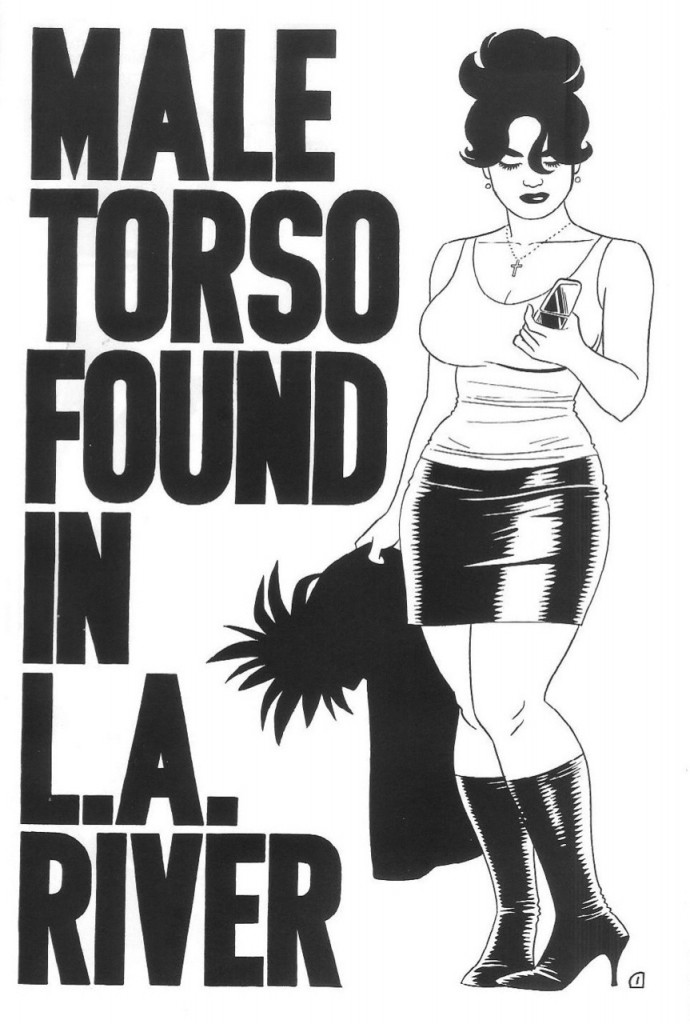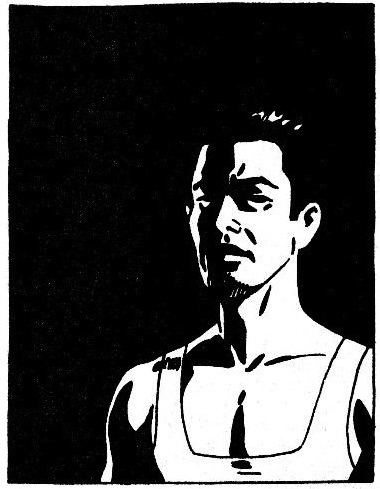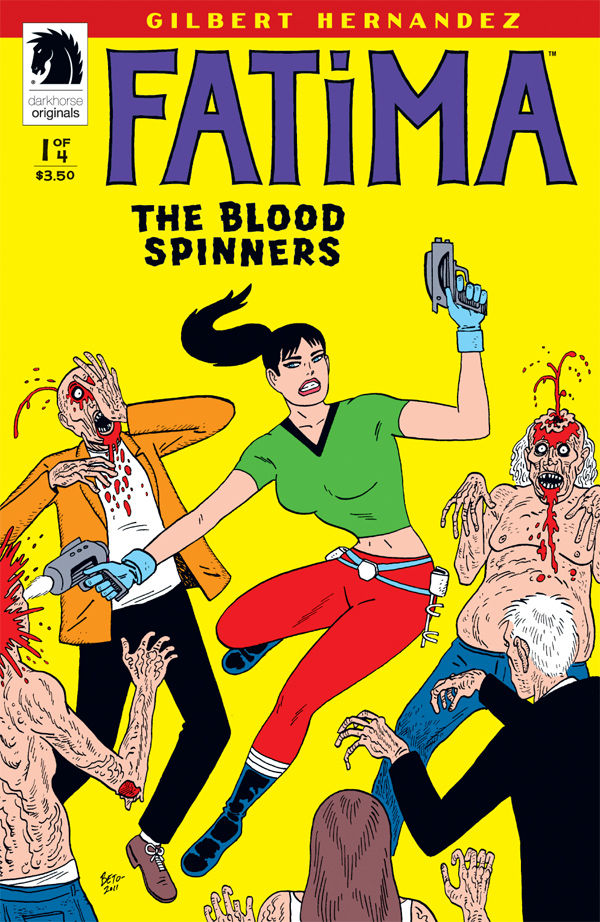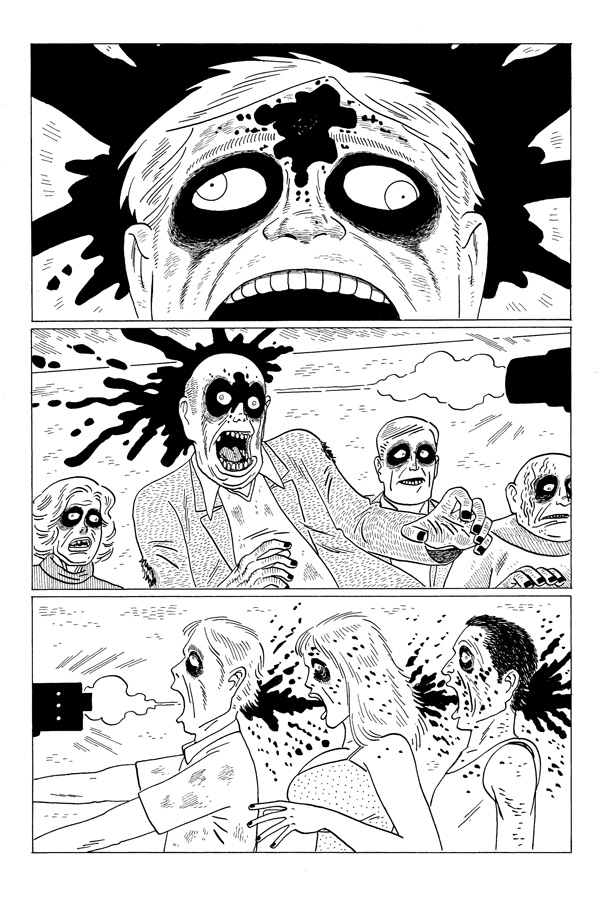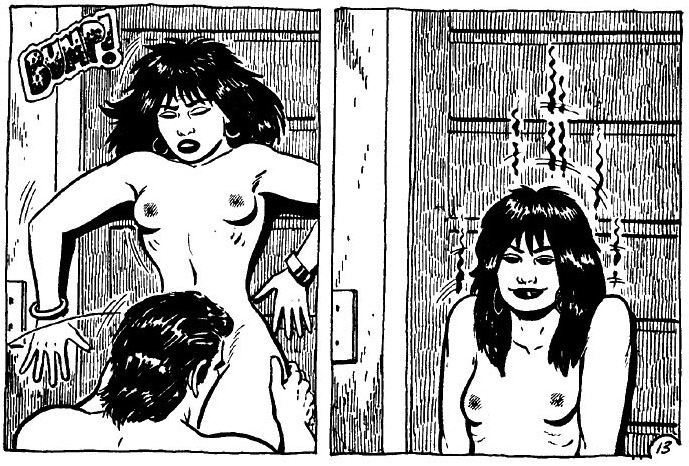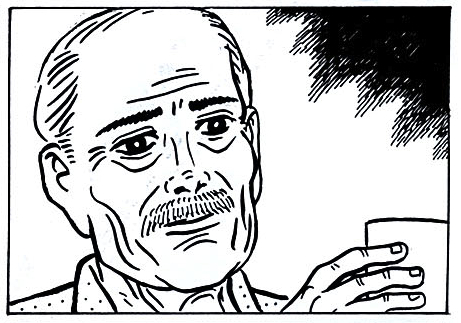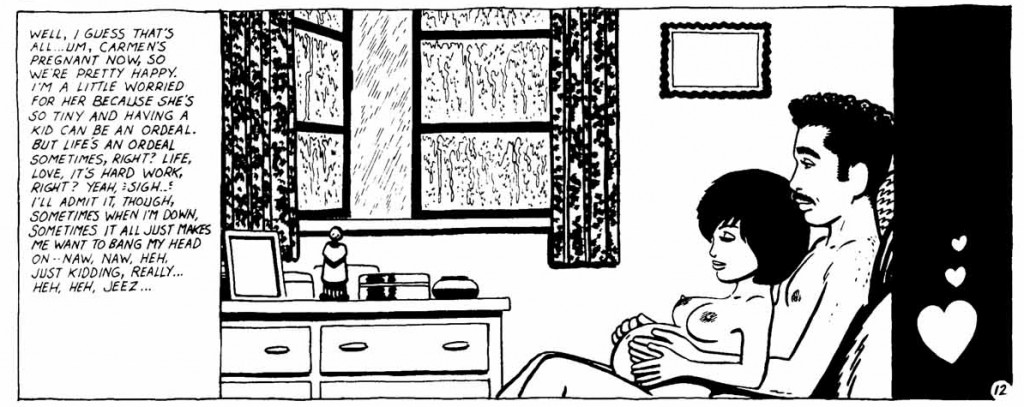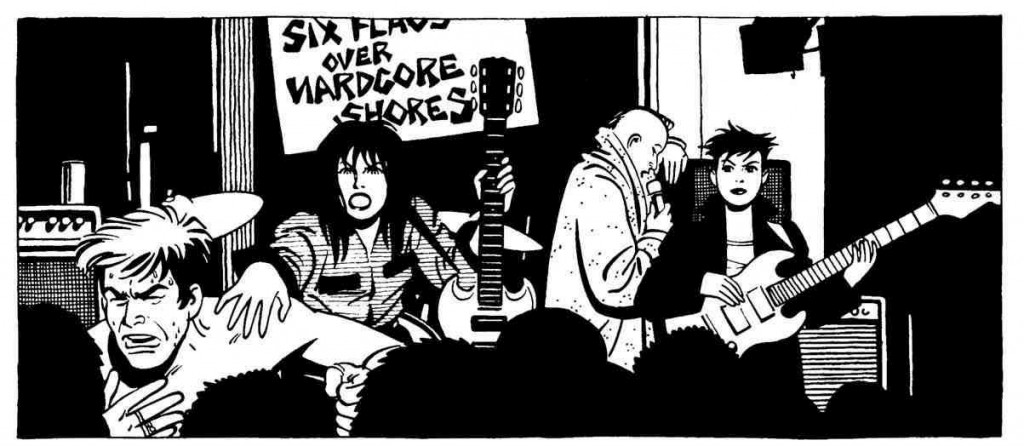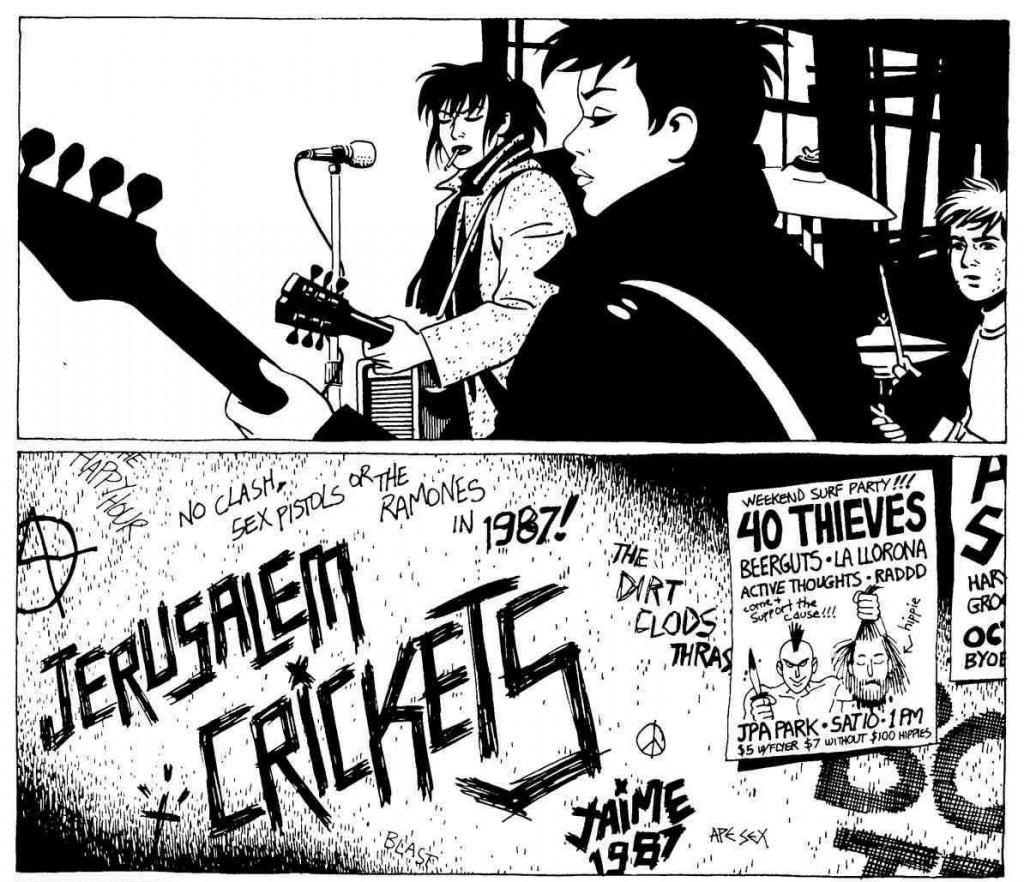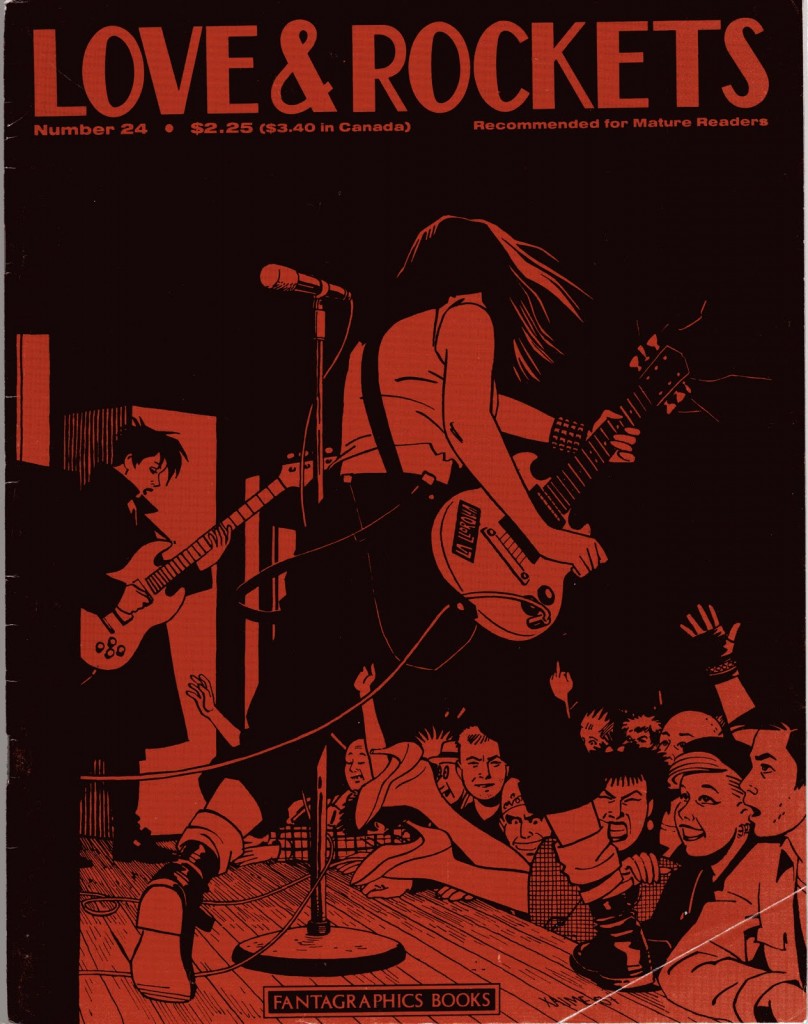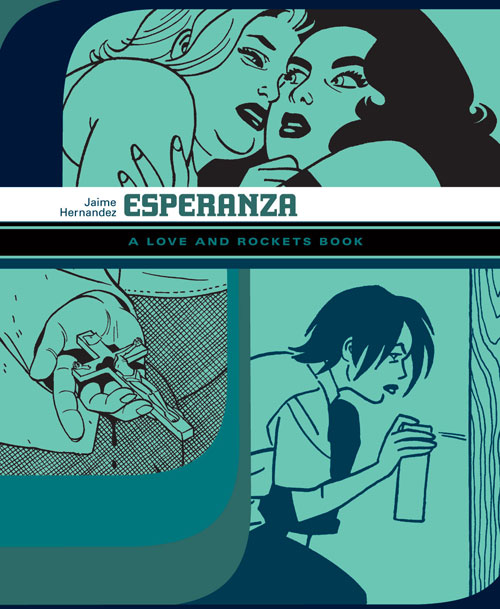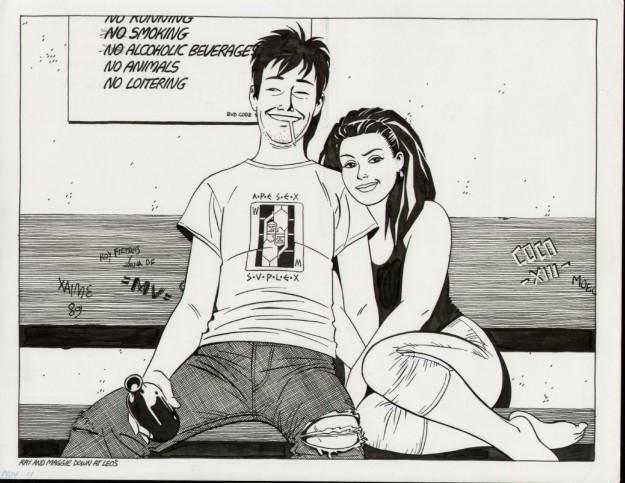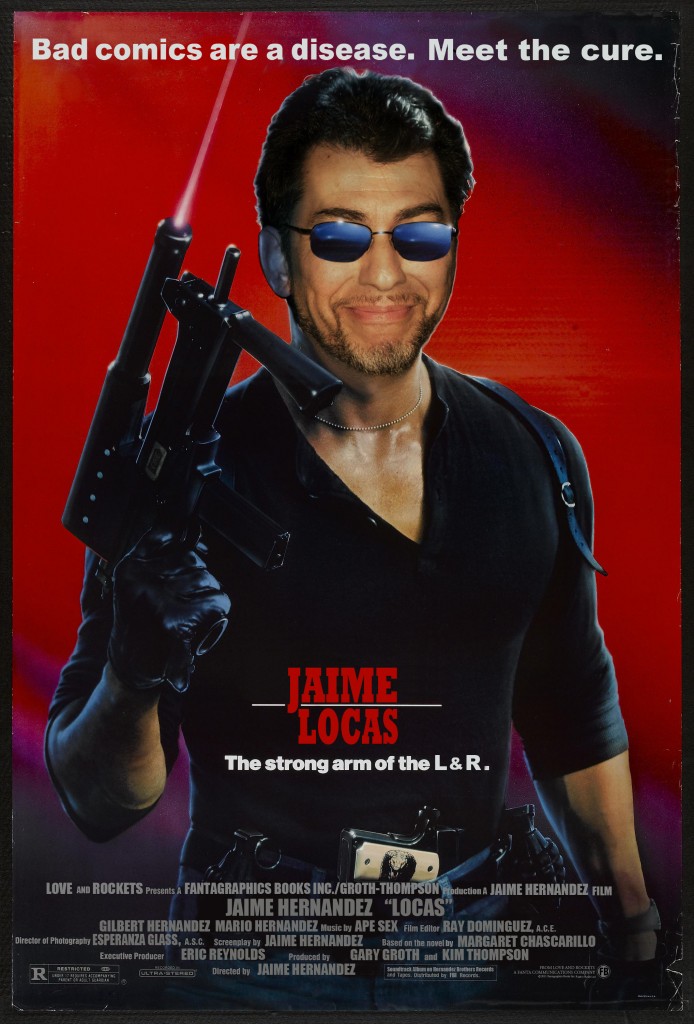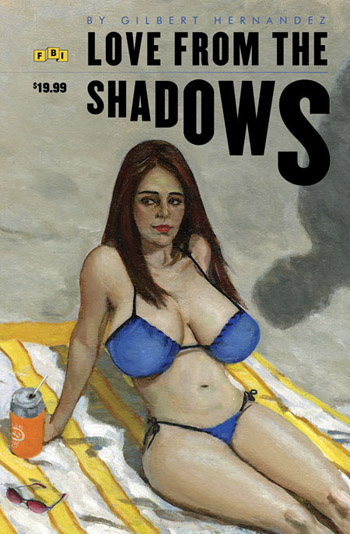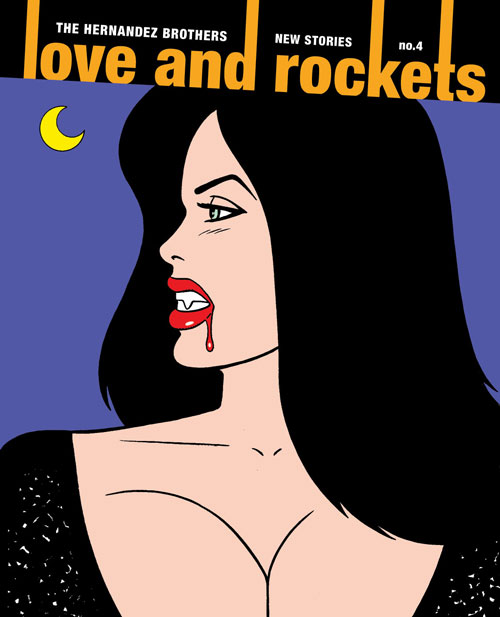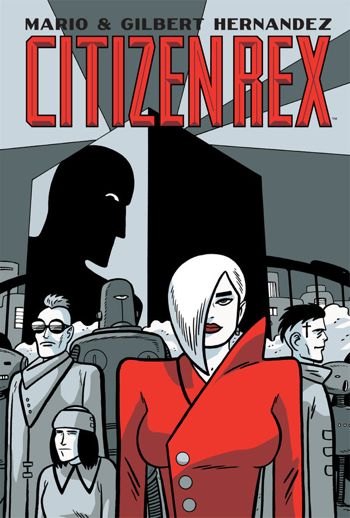Posts Tagged ‘Los Bros Hernandez’
Friday night with Vorpalizer
June 7, 2013Over the past couple of weeks I’ve written about Memory Palaces by Edie Fake, “The Sea-Bell, or Frodo’s Dreme” by J.R.R. Tolkien, “The Ghoul Man” by Jaime Hernandez, and “The Cask of Amontillado” by Edgar Allan Poe for Vorpalizer. Check them out.
The Gilbert Hernandez spotlight panel at SPX
October 8, 2012I hosted Gilbert Hernandez’s panel at the Small Press Expo, and here it is! I haven’t listened to it yet — how did it go?
I learned things I didn’t know before, and that’s a wonderful way to leave a panel you’re hosting.
The Four Horsemen
September 26, 2012I interviewed Jaime Hernandez, Chris Ware, Daniel Clowes, and Gilbert Hernandez for Rolling Stone. Comics game Mount Rushmore.
(photo by Meredith Rizzo)
How I spent my Saturday morning
September 18, 2012Your Love and Rockets 30th Anniversary thought of the day
July 14, 2012Gilbert and Jaime Hernandez have each been telling the stories of the same group of characters, continuously, for three decades. They’ve done lots of other stuff, Gilbert especially, but that’s the bulk of what they’ve done. No one else in comics has done it. No one’s even come close. Could someone else do it? Could someone else tell the life story of their characters, over an actual life span, and have a lot of people care passionately about where those lives end up? I won’t say it’s unimaginable, the idea of someone else doing it, because there are enough similar cases out there for you to imagine those other people doing it, and it’s only then that the gulf between Los Bros and everyone else becomes so clear. What if Bryan Lee O’Malley just kept going with Scott Pilgrim until he hit Vol. 30? What if Dave Sim had never lost his mind? What if all the B.P.R.D. spinoffs were written and drawn by Mike Mignola? What if Achewood were a comic book and Chris Onstad never burned out on it? What if Erik Larsen’s main touchstone for Savage Dragon were Márquez rather than Kirby? What if The Walking Dead were filled with Rick-level characters, instead of Rick and a bunch of other people for Rick to react to? What if Alison Bechdel made a series of Dykes to Watch Out For graphic novels instead of memoirs? What if Harvey Pekar had made stories up instead of writing them down? What if all of these things lasted for thirty years? And oh yeah, what if all of these people had siblings doing the exact same thing at the same time under the same title? It’s only when you see all the hoops one would have to jump through even to come close to what Beto and Xaime have accomplished that you really appreciate that hey, they’re the ones who built the hoops.
Love and Rockets, the great serial comic by Gilbert, Jaime, and sometimes Mario Hernandez, is celebrating its 30th anniversary at the San Diego Comic-Con International this week. Inspired by Tom Spurgeon, this week-long, daily series of posts will highlight some of my favorite things about Los Bros Hernandez and their comics. For more information, click here.
Your Love and Rockets 30th Anniversary thought of the day
July 13, 2012Any character in Love and Rockets stands a decent chance of being my favorite on any given day, because they are designed to be contemplated, and I’m the contemplative type. Today I’m thinking a lot about Tonantzin, one of the stars from Gilbert’s Palomar stories. She’s a stunningly hot small-town girl, so her rebelliousness first manifests itself by dressing provocatively and using sex to self-actualize. But her mind, heart, and psyche are all as dangerously overdeveloped as her body and sensuality, she gets swept up in a series of increasingly destructive obsessions, first with America and Hollywood, then with native culture and political protest, then with the danger of militarism and the possibility of nuclear annihilation. We can see that they all provide her with an emotional and intellectual way out of the confines of Palomar and her own body — indeed things start getting really bad when she’s taught to read — but because he never really describes it as such, we never realize how far she’s willing to go until it’s too late. Ultimately she comes to believe the only truly free intellectual and political act is to destroy the body she came in. It’s an unforgettable and utterly unique portrait of how good ideas and good people can nevertheless combine into something very bad. It’s a lesson that life entails losing vibrant, lovely people you neither want nor expect to lose. It’s a tragedy for a young woman and the people who love her. It’s a commentary on the hopelessness of the political climate of the day. Today I find myself wondering whether if she’d grown up in Hoppers instead of Palomar, and had punk and the Locas as a release valve instead of abnegative protest, would she still be alive today? On the flip side, would Speedy Ortiz still be alive if he’d grown up in Palomar instead of Hoppers, in a place where it was easier to form romantic relationships and harder to form ones based on a shared propensity for collective macho violence? This is the kind of thing you could do all day long with character after character after character from both Gilbert and Jaime. They’re drawn to be viewed from all angles.
Love and Rockets, the great serial comic by Gilbert, Jaime, and sometimes Mario Hernandez, is celebrating its 30th anniversary at the San Diego Comic-Con International this week. Inspired by Tom Spurgeon, this week-long, daily series of posts will highlight some of my favorite things about Los Bros Hernandez and their comics. For more information, click here.
Your Love and Rockets 30th Anniversary thought of the day
July 12, 2012Mario Hernandez is the great lost alternative cartoonist, the Lost Bro Hernandez. His interest in cosmopolitanism, leftist politics, the conflation of activism and terrorism by the authorities, the pas de deux between terrorism and authoritarianism, the revolutionary and counterrevolutionary power of art and pop culture, the Third World as a petri dish for first-world government’s reimportation of radicalism, all within the framework of vaguely science-fictional thrillers — he is in many ways the perfect comics-maker for our present moment. With its heavy use of blacks his style sits comfortably alongside those of his brothers, but its density and its bold slashing brushstrokes set it completely apart. If he’d had the time or inclination to produce the same volume of work, published with the same regularity, as his brothers, we’d likely have a third pantheon-level creator from the same generation of the same family, an astonishing thing to contemplate. As it stands we have a hidden treasure, a single gem in a stack of gems, and that’s not so bad either.
Love and Rockets, the great serial comic by Gilbert, Jaime, and sometimes Mario Hernandez, is celebrating its 30th anniversary at the San Diego Comic-Con International this week. Inspired by Tom Spurgeon, this week-long, daily series of posts will highlight some of my favorite things about Los Bros Hernandez and their comics. For more information, click here.
Your Love and Rockets 30th Anniversary thought of the day
July 11, 2012Jaime Hernandez is comics’ greatest maker of standalone images. His blacks, his typography, his sense of style, the drama of his line, the sense of balance and momentum even within a single image, his use of powerful moments to convey character, the whole nine. Out of all his peers in the ’80s and ’90s alternative comics movement — the stuff I think of as High Alt, the solo anthology series cartoonists who eventually coalesced around Fantagraphics and Drawn & Quarterly, Xaime and Beto and Ware and Burns and Clowes and Brown and Doucet and Bagge and Tomine and Sacco and Woodring and French — his makes him uniquely suited for the Tumblr era, when the rebloggable, context-free image is king. As such he stands the best chance of elbowing his way into the new canon currently being established as a reaction against High Alt and its forebears, consisting mainly of high-impact, visually dazzling genre comics whose work thrives in a one-at-a-time context — Kirby and Moebius and Otomo and Miller and Chaykin and Manara and pre-alt Mazzucchelli and McCarthy and Graham. But his best images often come within the flow of a story in addition to pin-ups, posters, covers, and title pages, and his interests broaden the canon-of-spectacle beyond solving problems through violence and/or sexy stylishness. They work equally well as vehicles for devastating emotional reveals, or as t-shirts.
Love and Rockets, the great serial comic by Gilbert, Jaime, and sometimes Mario Hernandez, is celebrating its 30th anniversary at the San Diego Comic-Con International this week. Inspired by Tom Spurgeon, this week-long, daily series of posts will highlight some of my favorite things about Los Bros Hernandez and their comics. For more information, click here.
Comics Time: Fatima: The Blood Spinners #1
July 11, 2012Fatima: The Blood Spinners #1
Gilbert Hernandez, writer/artist
Dark Horse, June 2012
24 pages
$3.99
Buy it from Dark Horse
For today’s Comics Time review, please visit The Comics Journal.
Your Love and Rockets 30th Anniversary thought of the day
July 10, 2012Outside of erotica and autobiography, no cartoonist has ever woven sex so indissolubly into the fabric of his comics as Gilbert Hernandez, in a fashion reflective of lived experience. In all of fiction comics, only writer Alan Moore comes close. This goes beyond simply drawing hot people, although before unfortunate circumstances intervene, Tonantzin and Khamo are probably the hottest woman and man in all of comics. Gilbert’s ability to describe and depict physical attraction between his couples frequently makes for the sweetest and most romantic aspects of those relationships—whether male or female, characters’ appreciation for their partners’ hips, tits, dicks, thighs, stomachs, faces and what-have-you, and for the pleasure those parts bring them, is often just plain adorable, however freaky or kinky or dirty things might get. But Beto’s larger argument appears to be that we can no more separate our physical desires from our lives than we can detach from our physical bodies in the course of living them. This of course has a dark side: Life is frequently terrible, and thus so is sex in Gilbert’s comics. And so his greatest creation, Fritz, is the em-body-ment of all these aspects of Beto’s work: She is the sweetest, sexiest, kinkiest, dirtiest, most tragic character of them all. There are no sex scenes in Beto’s comics—life is a sex scene, for better and for worse.
Love and Rockets, the great serial comic by Gilbert, Jaime, and sometimes Mario Hernandez, is celebrating its 30th anniversary at the San Diego Comic-Con International this week. Inspired by Tom Spurgeon, this week-long, daily series of posts will highlight some of my favorite things about Los Bros Hernandez and their comics. For more information, click here.
Your Love and Rockets 30th Anniversary thought of the day
July 9, 2012No cartoonist has ever captured the spirit of rock and roll — listening to it, watching it, performing it, defining your life with it — like Jaime Hernandez. Vanishingly few have even come close; most attempts are cringeworthy. Jaime not only nailed the style, and the intensity, and the specific idiom of his punk milieu (the graffito “NO CLASH, SEX PISTOLS OR THE RAMONES IN 1987!” in the panels below is worth more than entire critics’ bodies of work), and the nuts-and-bolts stuff like the body language of people playing music on stage, he also chronicled the lives of the characters involved long enough to be basically the only cartoonist ever to explicitly examine what it’s like when you grow up and grow older and discover that you no longer look and act and think like someone in the pit at your favorite band’s show.
Love and Rockets, the great serial comic by Gilbert, Jaime, and sometimes Mario Hernandez, is celebrating its 30th anniversary at the San Diego Comic-Con International this week. Inspired by Tom Spurgeon, this week-long, daily series of posts will highlight some of my favorite things about Los Bros Hernandez and their comics. For more information, click here.
Comics Time: Esperanza
April 4, 2012Esperanza
Love and Rockets Library: Locas, Book Five
Jaime Hernandez, writer/artist
248 pages
$18.99
Fantagraphics, 2011
Buy it from Fantagraphics
Buy it from Amazon.com
For today’s Comics Time review, please visit The Comics Journal.
You’ve come a long way, Jaime: or how I learned to stop worrying and love Love and Rockets
October 21, 2011I wrote about “getting into” Love and Rockets for Robot 6. It’s the culmination of a week’s worth of posts on the subject. Take a look.
He’s your worst nightmare
October 20, 2011Comics Time: Love from the Shadows
October 5, 2011Love from the Shadows
Gilbert Hernandez, writer/artist
Fantagraphics, 2011
120 pages, hardcover
$19.99
Buy it from Fantagraphics
Buy it from Amazon.com
For reasons unknown to me, I did not create a Comics Time entry for this review, which was posted on April 20 at The Comics Journal. I’m just rectifying the situation now. Please visit TCJ.com for the review.
Comics Time: Love and Rockets: New Stories #4
August 1, 2011Love and Rockets: New Stories #4
Gilbert Hernandez, Jaime Hernandez, writers/artists
Fantagraphics, August 2011
104 pages
$14.99
Buy it from Fantagraphics
Buy it from Amazon.com
Love and Rockets: New Stories #4 will turn any fan of Los Bros Hernandez into the host of The Chris Farley Show. “Remember? That time? When you drew Calvin’s plaid shirt? So that the plaid was always facing in the same direction? No matter how much Calvin moved?…That was awesome.” I am seriously finding it difficult, if not impossible, to review this comic without simply hitting the bullets-and-numbering button and whipping up a list of everything in it that amazed me. It would be a long list, too. But I’m abstaining as much as I can — to challenge myself for starters, and to avoid spoiling the comic for those of you who haven’t yet read it (which is probably most of you since it’s not out yet) for the most part. But I’m also holding off on that listicle because I think it’s a cheat. The fact of the matter is that while reading this book I discovered that I’m at least as attached to Ray Dominguez and Fritz Martinez, the protagonists of Jaime and Gilbert’s contributions respectively, as I am to a decent number of real people in my life. So sure, I could rattle off the ways in which Xaime and Beto continually prove themselves to be among the most graphically inventive and entertaining cartoonists alive some three decades into their careers — the crosshatching on Ray’s shirt and Maggie’s sofa; Gilbert’s use of wavy, puddle-shaped, impenetrable fields of black in his vampire story; the impact of the just-this-side-of-parallel lines of Angel’s body as she bends her leg to put on a high heel; the upside-down lava-lamp shape of Fritz’s legs in a skirt, used as an anchor for panel after panel of her simply walking around town with her agent ex; dredging up a long-ago, possibly long-forgotten character, drawing him as a late-middle-aged man in a way that makes him unrecognizable until you realize just how recognizable he is; the smashed-skull-as-cubist-masterpiece in Gilbert’s customary burst of horrifying ultraviolence; the holy shit moment when you realize the visual structure to that montage spread from Jaime’s story; Gilbert storming the ramparts of the vampire story and launching sex and violence back into it like payloads from a trebuchet; Jaime serving up a story whose snapshot style echoes comparable material from “Wigwam Bam” in significant and story-relevant ways; tracing the similarities and differences between Killer and Fritz via the characters they play, the use of their amazing bodies fraught with story information. And hey, look at that, I did rattle them off! But in the end, how it looks pales in insignificance next to what happens, because making it look that good is a means to the end of imparting just how much what happens matters. Ray’s shirt and Fritz’s legs, the shadow of the vampire and the structure of the montage — they’re just landmarks to remind you where you were when you found out if Ray and Fritz and Maggie were going to get happy endings, or not. It’s the easiest thing in the world to understand, and it’s the hardest thing in the world to do, and it’s magic, pure magic, to do it this well.
Comics Time: Citizen Rex
July 26, 2011Citizen Rex
Mario Hernandez, writer
Gilbert Hernandez, artist
Dark Horse, June 2011
144 pages, hardcover
$19.99
Buy it from Amazon.com
For today’s Comics Time review, please visit The Comics Journal.
Comic of the Year of the Day: Love and Rockets: New Stories #3
December 19, 2010Every day throughout the month of December, Attentiondeficitdisorderly will spotlight one of the best comics of 2010. Today’s comic is Love and Rockets: New Stories #3 by Gilbert Hernandez and Jaime Hernandez, published by Fantagraphics — career-best work from cartoonists with two of the best careers in the medium.
On Jaime’s “Browntown”/”The Love Bunglers”:
…ever since I read it, when I think of it, I just keep thinking to myself, “Poor [name]. Poor, poor [name].” It makes me want to cry! Cry for an imaginary person I’d never read about until a few pages earlier. (It’s the flipside of feeling proud of the entirely imaginary Hopey Glass for becoming a teacher’s assistant, I guess.) Such power!…I will never forget reading this book.
On Gilbert’s “Scarlet by Starlight”/”Killer * Sad Girl * Star”:
the brutal exploitation of children at the center of “Scarlet by Starlight” — delivered in a grotesquely matter-of-fact panel, savagely angry and awful — is echoed by the far milder but still insidious sexualization of “Killer * Sad Girl * Star” later on in issue #3…and, of course, it compliments and reinforces Jaime’s “Browntown”/”The Love Bunglers” suite in that same volume.
Click here for a full review of Jaime’s contributions to the issue and click here for a full review of Gilbert’s contributions to the issue; click either one for purchasing information.
LOVE AND ROCKTOBER | Comics Time: Love and Rockets: New Stories #1-3 and “Dreamstar”
December 8, 2010Love and Rockets: New Stories #1-3
featuring various stories by Gilbert Hernandez, writer/artist
Fantagraphics, 2008-2010
104 pages each
$14.99 each
Buy them for 33% off from Fantagraphics
Buy them from Amazon.com
“Dreamstar”
in MySpace Dark Horse Presents #24
Gilbert Hernandez, writer/artist
Dark Horse, July 2009
8 pages
Read it for free on MySpace.com (sorry, the permalink to the story isn’t working so you’ll have to scroll for it)
Buy it in MySpace Dark Horse Presents Vol. 4 from Amazon.com
“Fuck. Where’d all the good sex go? There used to be fuckin’ and sucking’ and pussy eatin’ and everything. Pussy eaten’ being my favorite. Now it’s rare to see sex much lately, unless it’s seen as sad or creepy or simply wrong. Shit, is that a cop?”–from “The Funny Papers”
“I didn’t get naked or do porn or have to suck anybody’s dick!! OK?!!”–from “Sad Girl”
“The naked maniac guys, the bloody cop, my up-the-butt daisy dukes…camera behind me getting a good close-up…I’ll take what I can get.”–from “Killer * Sad Girl * Star”
“They’re only animals! You did it! You did it too!”–from “Scarlet by Starlight”
The suite of stories Gilbert Hernandez contributed to the relaunched, graphic-novel-format Love and Rockets: New Stories might be his most complex work yet. By my count, you have two relatively straightforward strips, “Sad Girl” and “Killer * Sad Girl * Star,” starring Killer, Guadalupe’s teenage daughter and heir to the Luba/Fritz/Petra bombshell genes. You have a Fritz B-movie, “Scarlet by Starlight.” You have a movie Killer starred in, “Hypnotwist,” which was a remake of an earlier film we’re told; two other Killer movies are woven into “Killer * Sad Girl * Star.” You have an abstract strip called “?” with which “Hypnotwist” shares much of its visual vocabulary. You have a strip that’s similar in tone to his bleaker Palomar morality plays, “Papa,” and a similarly cold America-based strip called “Victory Dance.” Then you have a funny-animal goof called “Never Say Never,” an exercise in ’60s-style humor cartooning called “Chiro El Indio” that’s written by brother Mario, a trio of newspaper strips called “The Funny Papers,” and a kill-crazy rampage by the Martin & Lewis impersonators from Bela Lugosi Meets a Brooklyn Gorilla (seriously!) called “The New Adventures of Duke and Sammy.” Finally, there’s “Dreamstar” from Dark Horse’s defunct webcomics site at MySpace.com, which is still another film from Killer’s oeuvre.
It was only in reading Beto’s stories in all three volumes that the Chinese puzzle-box intricacy of what he’s doing here revealed itself to me. Much of this is accomplished by delaying the point at which we receive vital information. In “Hypnotwist,” we don’t see Killer appear until a pair of pages deep into the strange, wordless strip. Up until then we’ve been focusing on the imagery the strip shares with the previous volume’s “?”–giant smiley faces, a tumbling glass, ducks, a door with a question mark; meanwhile, the meager information about Killer’s first movie we learned in “Sad Girl”–it involved a lot of green-screen work and running in place in a trenchcoat designed to make her look nude underneath–doesn’t tip us off about anything in “Hypnotwist” until Killer herself shows up. “Scarlet by Starlight,” meanwhile, never tips its hand, not even with subtle deviations like the hair-color games Chris Ware played with his similar sci-fi/horror story-within-the-story in ACME Novelty Library #19. Unless you happen to remember the title from Fritz’s strips, or the endpages in The Troublemakers and Chance in Hell, there’s no way to tell it’s a “movie” from the Palomar-verse until you see Killer watching part of it in the following strip. Fritz herself is buried under cat-person make-up and her humanoid speech doesn’t give her lisp occasion to manifest. (I know she has other identifying characteristics, but let’s face it, when it comes to deducing the identity of Beto characters, “giant breasts” hardly narrows it down.) In “Killer * Sad Girl * Star,” one of the movies Killer stars in is presented in such a fashion that it seems to be real life. “Victory Dance” starts out like a non-narrative exploration of figurework a la “Heroin” from Fear of Comics before becoming a story about a relationship haunted by the spectre of death and one member’s fleeing from it a la “Papa,” and finally revealing itself to be set in “Papa”‘s world. “Papa,” meanwhile, could be a Palomar-verse strip for all I know–I’d need to go back and see if mudslides or poisonous worms were ever a feature of Palomar’s surroundings. “The New Adventures of Duke and Sammy” plays “Papa” and “Victory Dance”‘s relationship/travelogue tragedies as farce. “The Funny Papers”‘ sub-strip “Meche” evokes a key backstory element in the Fritz comics, while “It’s Good to Be…” (quoted above in its entirety) seems to be a direct commentary on Beto’s current approach to sex in his comics. As is custom, the films we see the characters acting in are all reflective of the issues of sexuality that dominate their own lives. Specfically, the brutal exploitation of children at the center of “Scarlet by Starlight”–delivered in a grotesquely matter-of-fact panel, savagely angry and awful–is echoed by the far milder but still insidious sexualization of “Killer * Sad Girl * Star” later on in issue #3…and, of course, it compliments and reinforces Jaime’s “Browntown”/”The Love Bunglers” suite in that same volume. All in service of what feels like an extension of the flagellating self-critique we saw in High Soft Lisp, the quotes above being Exhibit A.
And I could probably go on! But to do so would be to imply that trainspotting is the primary value of these comics. I could just as easily enumerate the innumerable pleasures of Gilbert’s cartooning itself in these strips: The wire-thin, unwavering line with which he draws the legs of the protagonist of “Hypnotwist,” say–a style I’ve never seen him use before. That choreography in “Victory Dance.” The emergence of vast, hellish landscapes as a no-doubt-about-it theme in Gilbert’s work with the opening of “Papa.” The dead-behind-the-eyes facial expressions of the humans in “Scarlet by Starlight.” The sequence in “Hypnotwist” where a balloon-headed man’s head is popped, leaving it sagging horrifically off his neck as he crawls in the nude. The WTF repetition of the Masonic square and compass. The unexplained holes in Papa’s head. Killer as a heavy-lidded Luba lookalike. Hector as a wild-eyed gray-haired hot-tempered eminence grise.
All told, you could wrap these stories up between two covers and come up with a book of absolutely crushing intelligence, emotional heft, and visual power–a book among the best of Gilbert’s career. And by #3, Jaime is hitting a similar career peak, playing off of similarly uncompromising themes. Here I am at the end of over two months of reading nothing but going on three decades’ worth of Love and Rockets, and neither I nor Los Bros Hernandez are anywhere near exhausted. All hail.
LOVE AND ROCKTOBER | Comics Time: Chance in Hell
November 29, 2010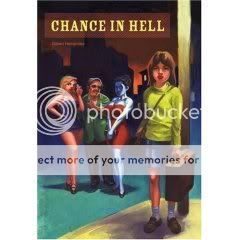
Chance in Hell
Fantagraphics, September 2007
Gilbert Hernandez, writer/artist
120 pages, hardcover
$16.95
Buy it from Fantagraphics
Buy it from Amazon.com
(Note: I originally posted this review on January 18, 2008. This was before I’d read much, if any, of Gilbert’s Fritz material from Love and Rockets. I think the review holds up, which is why I’m re-running it; but with all of Beto’s post-Palomar Palomar-verse work under my belt now, if anything I find Chance in Hell, both its content and its very existence, even more disturbing. On a story level, the “movie” from which the graphic novel is “adapted” turns out to be a “what-if” for its co-star Fritz (whose prostitute character in it doesn’t have a speaking role), featuring a protagonist whose life easily could have been Fritz’s if her mother Maria had been just a bit more heartless or her father Hector just a bit more awful. But that right there’s the thing: Gilbert basically takes the single worst thing ever done by anyone in any of his stories, turns up the volume on it, and builds a new, even more violent and hideous story around it. “Some carry the pit in them for the rest of their lives,” says the book. And later: “There’ve been people who’ve survived, but each has carried with him a distinct odor for the rest of his life. A unique smell that he could never remove. Like mine. Like the smell I carry and must mask with a special cologne of my own design. Is there something you must mask?”)
—
Rough, rough stuff from the creator of Palomar. Hernandez is in the midst of creating graphic novels based on the B-movies that his Palomar-verse character Fritz starred in, but “B-movie” might give you the wrong impression here. This isn’t one of those howlers the bots made fun of on MST3K–it’s the kind of disturbing, unpleasant film starring and shot by unknowns that you might rent on a whim from the horror or European section of your old neighborhood video store, watch, and spend the rest of the evening worried about the mental health of cast and crew. The story concerns Empress, an orphaned toddler abandoned in a sprawling, dog-eat-dog garbage dump and raped so frequently that she doesn’t even seem to notice anymore. A farcical string of bloodily violent incidents leads her to a life as the unofficially adopted daughter of a poetry editor who claims to have come from the same circumstances, and then eventually to a second life as the wife of a young district attorney, but in both cases violence and squalor cling to her like a stench, to use a frequently invoked metaphor.
This is the angriest I can ever recall Gilbert’s art looking. That’s saying something: My wife, for example, finds his books almost difficult to look at–“His characters just look so hard,” she says, and they’ve never been harder than here. Right from the get-go his figures seem dashed off as in a white heat, while several early landscapes and backgrounds in the hellish dump look like the whole world is on fire. His almost supernaturally confident pacing of scenes and the cuts between them evoke in their matter-of-factness the acceptance of everyday brutality by the characters themselves. At times the jumpcuts can be quite funny, as when a scene between Empress and her adopted father consists solely of a pair of panels where they argue over whether a glass is half empty or half full; both Hernandez and his characters know how reductive this exchange is, yet also know it’s quite true to who they are.
But when that metronomic editing slows down, the effect is powerful, particularly because it is often done to draw out scenes of gutwrenching violence or tragedy. (The centerpiece scene in the brothel is as disturbing as the death squad attack in Gilbert’s masterpiece Poison River; there as here a knowing glance is all-important, but here it causes murder rather than prevents it.) The end of the book changes the pacing again, revving up the jumpcuts to suggest unsolved crime and unglued minds, and to be honest I’ve revisited it three or four times today and I’m still not sure what’s going on. Maybe that’s a problem, maybe it’s not. Since I see myself revisiting this book, a gruesome, enraged commentary on just how shitty things can be, many, many times in the future, I’m leaning toward “not a problem at all.”

